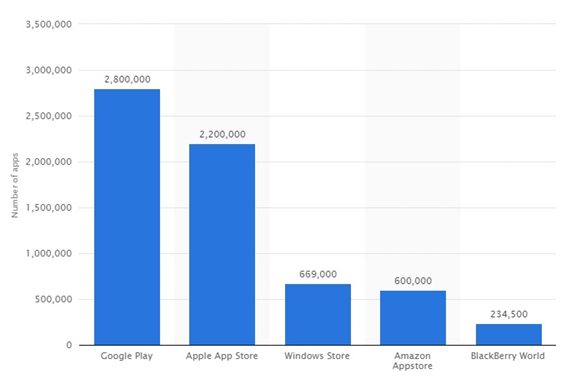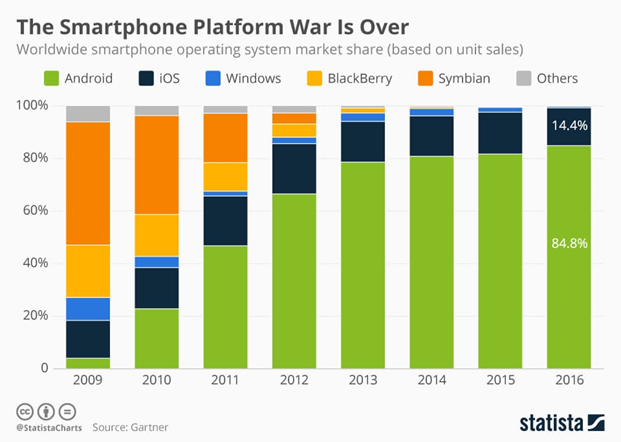Mobile Application Development
5 Strategies for Success for your Mobile Application

Mobile Ecosystem - A Roundup
Even though the number of mobile apps is in the millions, that doesn't stop developers from creating more apps. If you have ever thought about developing a mobile app for any of the two major platforms; Android (with 83% of users) or iOS (with 16.5% of users), consider these statistics from BusinessofAps.com:
- 700,000 new apps were submitted to the Apple AppStore between Summer of 2015 and March 2017
- One million new apps were submitted to the Google Play store between the winter of 2015 and March 2017
- Amazon AppStore saw growth of 200,000 apps from Spring 2015 to March 2017
- Total number of app publishers: 620k (Google Play) and 400k (App Store)
To say there's a lot of competition between app developers is an understatement. To make matters even glummer, Gartner predicts that by 2018 less than 0.01% of consumer mobile apps will be financially successful.
Number of apps available in leading app stores as of March 2017

Although it seems like an overcrowded market, here are the 5 strategies to be successful in developing mobile apps:
Strategy 1 — Approach
Ideas are a dime a dozen. If you don't have something that stands out above the rest, chances are your app won't be successful. Think of the many different educational, dating, fitness, weather, language learning, shopping, and photo editing apps that exist. There seems to be an app for everything these days, and you'll have to compete with all of them.
You can't just build an app and hope it will get millions of downloads. You should take many things into consideration, such as knowing the market and target users. Geographic segmentation is also important. For example, will your app be built to serve a purpose for a specific city, country, region or group? Treat app creation as if you're starting an actual business — especially if you're planning on making money with the app. You must have a business plan that sets your roadmap for the app you're creating.
Also — make sure that you create the app for the right platform for the target audience — the most prevalent platforms are Android & iOS.

Another strategy is to create an app that stays relevant. One way to prepare for the future is to include built-in analytics and push notifications to reach consumers. Built-in analytics is important to allow you to compile data and use it to identify new opportunities. Push notifications, on the other hand, boosts app engagement and therefore, helps users access the app more often.
Tapping into underserved markets is another way for an app to stand out. Creating an app for a target market with known problems but no real solution will fill a need in that niche. In other words, make an app that's useful, especially to consumers who need it most.
Strategy 2 - Quality & TTM
When creating an app, Proof of Concept (PoC) will aid in making it a better product. POC is what you need to find evidence, most of which can be done through testing, that validates the feasibility of your app's creation. Another point to consider is the Minimum Viable Product (MVP) technique, which means developing an app with sufficient features to satisfy initial users to allow you to seed the market.
Don't spend a lot of time and money to build a perfect app. Chances are you're not getting paid to build it. The key to an app that stands the test of time is quality and Time to Market (TTM). A quality app is one with "app stickiness," or long-term app use. The formula for app stickiness is:
Power Users (% of people who launch an app 10+ times/ month) + Loyal Users (% of people who return to an app within 3 months of first use) = App Stickiness
It goes without saying that you need to build a good app. Simply put, if your app isn't a good one, no one will want to use it. Get your app out into the world and see if your idea resonates with consumers. Get feedback from friends and family, talk to as many people as you can to make sure that people can understand what your app does, and how it works.
Time to Market, which is important for products that become outdated, is the time it takes from an app being in the design stage until it's available for sale or use. This is especially important in the app market as technology changes ever so quickly, and getting the app out when it is still relevant is pertinent.
Lastly, you must build for the platform because users and user experience and expectations differ. Will you be designing for iOS, Android or both platforms? Whichever platform you are building for, make sure you follow the design and UI/UX paradigms of the platform your designing for.
Strategy 3 - Discovery
You've read about the multitude of apps available for both mobile platforms. So how can an app be discovered in the sea of apps? Here are a few options:
- App Store Optimization (ASO) - Through ASO, the visibility and ranking of a mobile app is improved in an app store. This results in more downloads. ASO makes use of an app's title, keyword selection, and description in addition to having an icon, screenshots, and even video.
- Search Engine Optimization (SEO) - Similar to ASO, Make sure you have an associated web site with SEO enabled.
- Social Media Marketing - Only having a web page is not enough, you should also market your app through Twitter and by having a Facebook page for the app.
You can't just wait to be found. You have to find ways to drive users to your app in order to be noticed. Promoting your product to reach users and drive downloads can be achieved by increasing your visibility and ranking in app stores.
An app has to function well and have a unique look to help draw attention to it. Refined and user friendly interfaces make for a great app but that's not enough. Companies like UnfoldLabs can help you with ASO, Social Media Marketing and icon and keyword improvement. You may want to invest in having a logo professionally designed and a description for your app professionally written.
Strategy 4 - Distribution
One of the key elements in marketing, including marketing apps, is distribution and placement in order to get your product to users. One way to do this is to seek out third party app stores that focus their distribution on your niche market. Examples of these stores include Amazon App Store, AppBrain and Aptoide. Regardless of which you pick, make sure the store has a focus on your target market. You should also optimize being discovered in searches in search engines, using social media to promote your app and offer free downloads.
In addition to the OS app store, operator App Stores, such as the neXva branded stores, that have 300M users is another way for mobile app developers to get their apps noticed. The company gives app developers the chance to be visible in app stores globally through advertising campaigns, as well as help developers with monetization and, because of their relationship with mobile operators allows for highly targeted geographic segmentation.
Strategy 5 - Monetization
Just building an app isn't good enough - how will you make money? Will it be through B2B or B2C markets? B2C (Business to Consumer) is the traditional way of selling a product, and usually involves convincing consumers that they need the app you developed.
By utilizing dynamic ad insertions, app creators can make a profit through ads targeted to individual users. Video advertising, which reaches audiences using several platforms, including web pages and smartphones, is another way to make money with your app.
Some numbers on video marketing from Hubspot are:
60: Percentage of users more likely to make a purchase online after watching a video
87: Percentage of online marketers use video to connect
90: Percentage of users that say watching a video helps in making a decision
92: Percentage of mobile video consumers that share videos
80: Percentage of users that recall an add they viewed in the past 30 days
36: Percentage of online viewers that trust video ads
139: Percentage by which brand association is increased through video ads
97: Percentage by which video ads increase purchase intent
Moreover, by using third-party carrier billing solutions, app developers can make money by providing features such as subscription billing. They may also enable alternative payment methods, like using mobile money accounts, which means reaching those who don't have credit cards to make payments in markets with low credit card penetration.
App store monetization is another strategy to make money from apps. You can make money each time your app is downloaded, download the app for a free trial in hopes that consumers purchase the app, and/or offer freemium downloads, which means allowing consumers to download an app at no cost with some enabled features, but paying for additional features.

Our Take
Competition is certainly fierce in the world of mobile app development. Everyone wants to be the next app billionaire, following in the footsteps of successful developers who created apps like SnapChat and WhatsApp.
The process of building an app may be difficult but capturing the attention of the increasing number of smartphone users is even more challenging. Whether your app will succeed in the ever-growing list of apps available is a matter of how you market it. What will differentiate your app from other apps that have already been created and available for use?
As mobile apps continue to generate profits, the app market has become a free for all. However, for an app to be successful, it's not simply a matter of making an app, but having the tools to market the app to distinguish it from the millions of other apps available. The 5 strategies on how to survive the mad rush to create the newest and best app will help you create apps like a pro and greatly improve your chances for success.
. . .
. . .
This post was written by Asokan Ashok, the CEO of UnfoldLabs. Ashok is an expert in driving customer insights into thriving businesses and commercializing products for scale. As a leading strategist in the technology industry, he is great at recommending strategies to address technology & market trends. Highly analytical and an industry visionary, Ashok is a sought after global high-tech industry thought leader and trusted strategic advisor by companies.
. . .
Entrepreneur. Inventor. Product Ideation. Strategist. Visionary. Evangelist. Architect.

